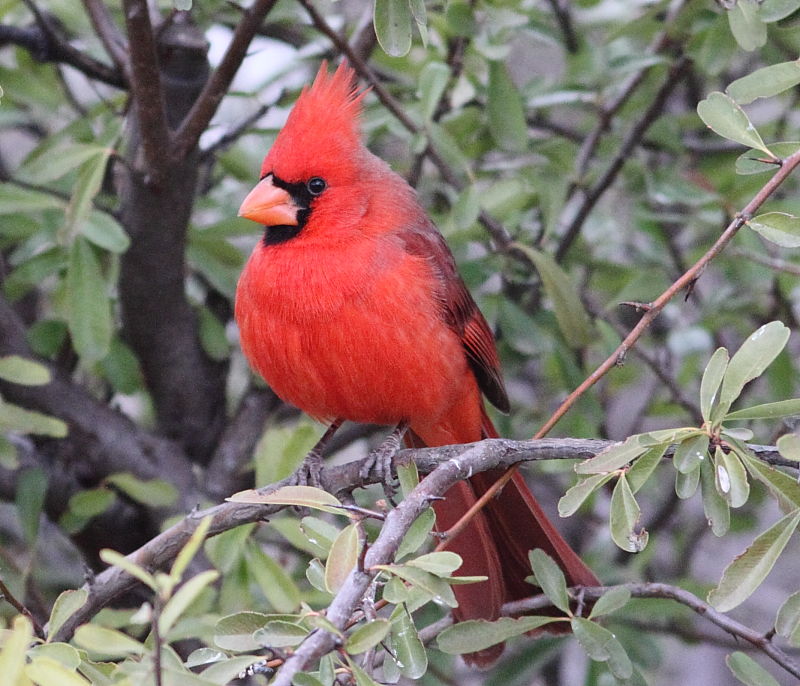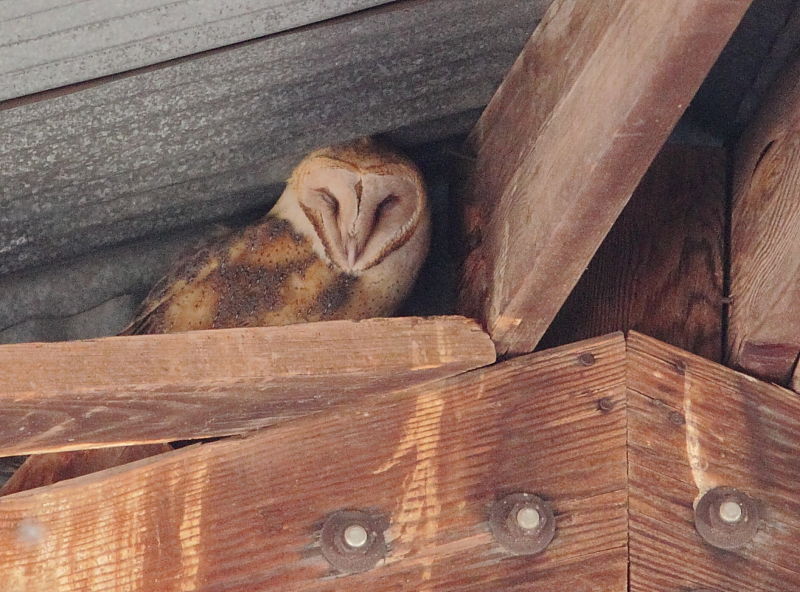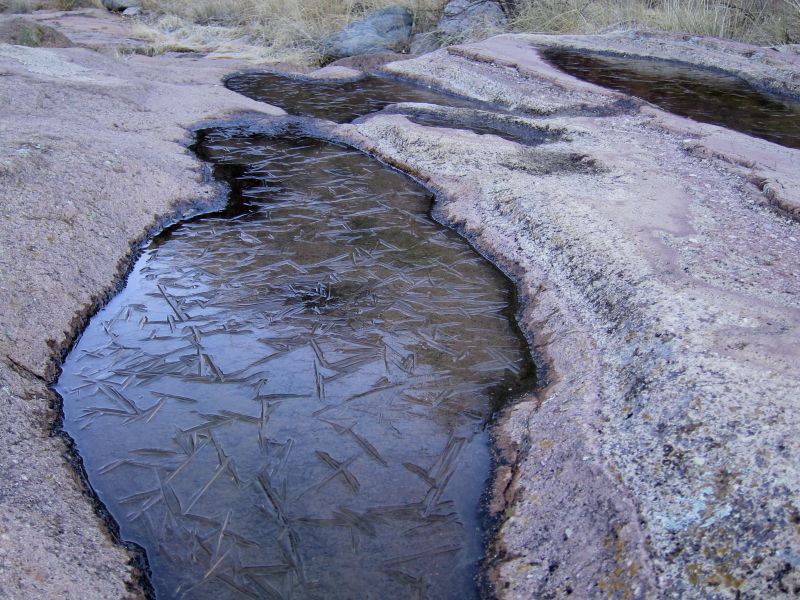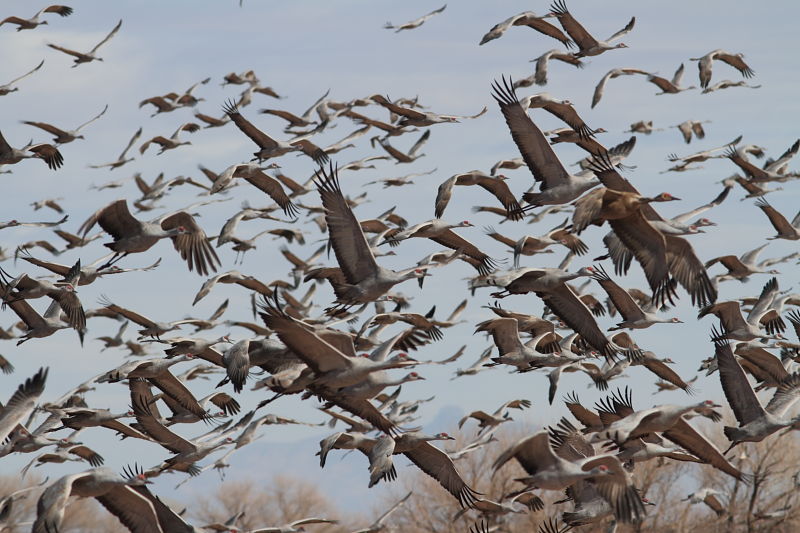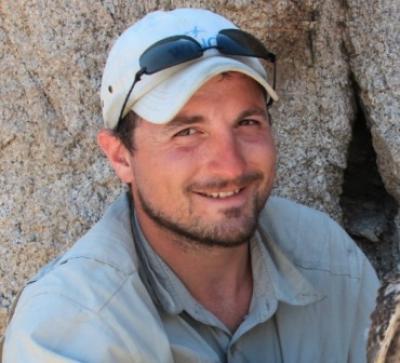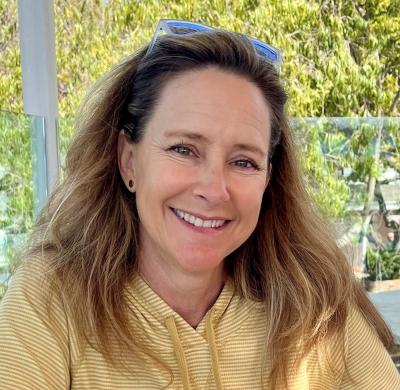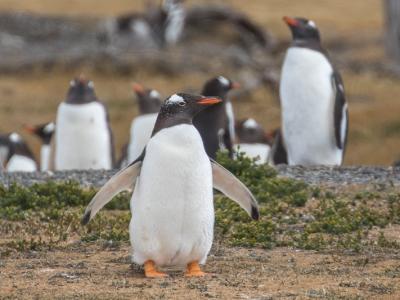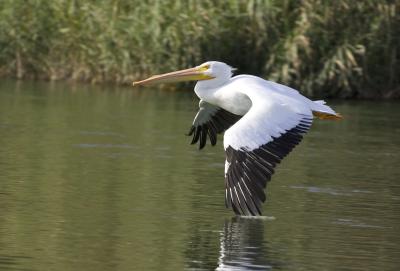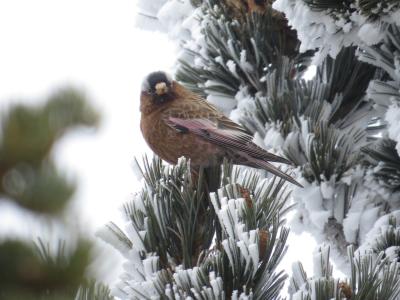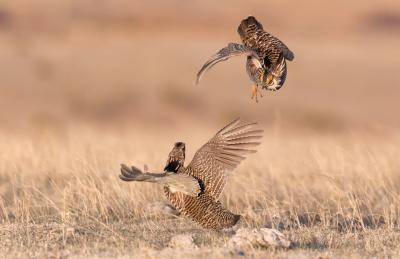Arizona: A Winter Week in the Southeast
-
Jan 26 to Feb 2 2025
Jake Mohlmann
-
Jan 25 to Feb 1 2026
Jake Mohlmann
2026 Tour Price to be Determined
2026 Tour Price to be Determined
This short winter tour covers a slice of southeastern Arizona at a time when bird populations are high—in some cases spectacularly high. We’ll visit imposing mountains, desolate canyons, vast grasslands, desert lakes and streams, and a few favored human-made sites. We’ll look for the area’s specialized avifauna, search for rarities along our route, and talk about what we’re seeing.
Other than our bookend nights in Tucson, we’ll stay at the charming Casa de San Pedro, a beautiful place with perfect night skies and birds just outside the door.
Day 1: The tour begins this evening in Tucson. Night in Tucson.
Everything was perfect. Jake is a superb leader with tremendous birding skills as well as great people skills. The B&B was comfortable and charming, and the food ws fantastic. Even the birds put on a show, and Jake had us in a perfect place to watch. - MaryAnn T.
Day 2: We’ll depart to the south, stopping in Madera Canyon in the Santa Rita Mountains, where we’ll be met in the lower canyon’s oaks by Arizona Woodpecker, the gregarious Mexican Jay, Bridled Titmice, and perhaps a stunning Painted Redstart. We’ll pause in desert scrub along the way to look for Rufous-winged and tinkling Black-throated Sparrows, among other inhabitants. Continuing east through Box Canyon, we’ll emerge in rolling grasslands, where perhaps we’ll see Meadowlarks and Quail fleeing from roadside fences.
We’ll pass through Sonoita in the heart of Arizona’s wine country, where various sparrows and raptors exploit the vast open lands, and continue east toward the north-flowing San Pedro River and Casa de San Pedro, our very comfortable home for the next five nights and a superb place to come back to on a winter’s late afternoon. Night at Casa de San Pedro near Sierra Vista.
Days 3–6: From our base at Casa de San Pedro, we’ll fan out in all directions, letting weather and circumstances determine each day’s destination. In general we’ll work from the farthest spot west, in and around Patagonia, and continue a bit farther east every day until we end up in the celebrated Chiricahua Mountains.
We’ll visit Patagonia Lake State Park, where typical birds include Ash-throated, Gray, Hammond’s, and Dusky Flycatchers, and with luck an Elegant Trogon or Black-capped Gnatcatcher, species that have occurred here in very low numbers in recent years. We’ll also visit feeders in Patagonia proper, where a few striking Violet-crowned Hummingbirds often winter and Lazuli Buntings add electric blue to the color palette. The Patagonia city park with its large trees often ripe with fruit, can harbor interesting wintering species such as rare sapsuckers or Hepatic Tanager.
We’ll explore the Huachuca Mountains and the San Pedro River drainage. What we do here will depend to some extent on what we’ve seen during the tour’s first days. Several wonderful canyons on the eastern slopes of the Huachucas can hold tooting Northern Pygmy Owls or Montezuma Quail. The San Pedro River sometimes has a Green Kingfisher in residence, often detected by its softly penetrating call, like two stones tapped together.
We’ll spend a day in the Sulphur Springs Valley, where given reasonable water levels we’ll witness the mass arrival at Whitewater Draw of thousands of Sandhill Cranes from their morning’s foraging. At its best, it’s a spectacular, occasionally deafening experience as multitudes of birds return from feeding on waste corn and other crops in the valley. In addition to the cranes, Whitewater holds a mix of other waterbirds, often including a shimmering cloud of Snow and Ross’s Geese.
The primitive appeal of large birds in such high numbers is undeniable, but for some the real attraction of the Sulphur Springs Valley is the mass of sparrows, buntings, and raptors that are drawn to all the food that this well-watered valley provides. It’s never quite the same from one year to the next, but regal Ferruginous Hawks are common and Red-tailed Hawks in all their bewildering variation are abundant. If it’s a good seed year, waves of White-crowned and Brewer’s Sparrows pour over the landscape and the soft, whistled “whew” of Lark Buntings is everywhere. Among the less common denizens we may encounter are Mountain Plover, buffy-faced Bendire’s and streaky Sage Thrashers, or perhaps Thick-billed Longspur.
No trip to southeast Arizona would be complete without a visit to Portal at the mouth of Cave Creek Canyon in the heart of the mighty Chiricahua Mountains. Several types of habitats converge in this area and the bird diversity is reflective of this. In the big thicket just outside town we’ll look for the very shy Crissal Thrasher, the recently split Woodhouse’s Scrub-Jay, and spry Black-tailed Gnatcatcher. Portal proper has numerous feeder arrays and we’ll hope to see Rivoli’s Hummingbird and Blue-throated Mountain-gems, both distinct possibilities this time of year. If the road conditions allow us to head into the higher reaches of the mountain range we’ll have a chance to cross paths with Mexican Chickadee, this being the only place north of Mexico one can see this range-restricted species. Nights at Casa de San Pedro near Sierra Vista.
Day 7: After our last delicious breakfast at Casa de San Pedro, we’ll return to Tucson. This desert city is a magnet for wintering birds, usually including something rare. We’ll take time to visit parks and lakes scattered throughout the Tucson Valley, searching for stakeouts and resident species associated with the Sonoran Desert we may have missed. We’ll finish the day with an afternoon stroll around Tucson’s Sweetwater Wetlands, a wonderfully accessible collection of ponds and scrub that holds hundreds of ducks and wintering passerines. As the afternoon fades and dusk sets in, impressive numbers of blackbirds, including male Yellow-heads, come in to overnight in the reed beds. Night in Tucson.
Day 8: The tour concludes this morning in Tucson.
Note: The information presented below has been extracted from our formal General Information for this tour. It covers topics we feel potential registrants may wish to consider before booking space. The complete General Information for this tour will be sent to all tour registrants and of course supplemental information, if needed, is available from the WINGS office.
ENTERING THE UNITED STATES: Non-U.S. citizens will need a valid passport and may need a tourist visa. Consult your nearest U.S. Consulate for details.
Canadian citizens should carry proof of citizenship in the form of a passport. Please note that non-US citizens are required by law to carry passports/visas with them at all times.
U.S. citizens should bring their driver’s license, birth certificate and/or passport.
PACE OF THE TOUR: Under normal circumstances no major hiking is required but on occasion, depending on what birds are visiting for the winter and the group’s abilities, we may attempt some brief rock scrambling. A hike of up to 3/4 mile into a mountain canyon with elevation gains upwards of 500 feet may be possible. The longest walk on the tour would be 1-2 miles at an easy pace on level ground through the grasslands looking for various birds.
HEALTH: Arizona presents no real hazards to the visiting bird-watcher but certain factors must be considered.
Elevation: In Tucson we will be staying at 2,600 feet and while in Sierra Vista our hotel is at an elevation of 4,250 feet. If there is no snow on the mountains we may go birding up to 8,000 feet. While at this elevation foot travel will be limited to walking less than ¼ mile from the vehicle.
Sun: Winter sun is powerful and deserves respect. Please bring and use sunscreen as well as a broad-brimmed hat.
Spiny Plants: The most common injury results from spines penetrating light-weight canvas shoes though the sides and soles. Many desert plants are armed with thorns or spines, and native grass seeds can be a nuisance.We recommend tough canvas or leather shoes of at least ankle height and tough trousers as the best safeguards.
Dehydration: Dehydration is a constant concern in Arizona especially when birding at lower elevations in the desert. Drinking a lot of water is highly encouraged throughout the tour. The leader will always have an ample supply of water in our vehicle and make frequent pit stops along the way to use the bathroom facilities.
Smoking: We request that you do not smoke in the vehicles or when the group is gathered for meals, checklists, etc. If you are sharing a room with a non-smoker, please do not smoke in the room. If you smoke in the field, we ask that you do so well away and downwind from the group. If any lodge, accommodation or location where the group is staying or is gathered has a more restrictive smoking policy than WINGS’ policy, the more restrictive policy will prevail.
CLIMATE: In winter (November to February), daytime highs are in the 60-70° range with nighttime lows in the 30s and 40s F. It can be colder at high elevations and it is always possible to experience days with maximum temperatures of 10°F above or below these figures. Be prepared for early morning temperatures below freezing, sometimes in the single digit temps. Rain is infrequent but periodic storms can produce precipitation throughout. Snow is regular above 6000 feet and as low as 3000 feet.
ACCOMMODATIONS: We stay at a standard motel in Tucson near the Tucson Airport, but elsewhere our lodging is of an unusually high standard. Casa de San Pedro Bed & Breakfast (http://bedandbirds.com/) sits on ten acres adjacent to the San Pedro River and Riparian National Conservation Area on the eastern edge of the Huachuca Mountains.
Wireless internet is available in all places we stay.
FOOD: Breakfasts and several catered dinners will be at Casa de San Pedro. We may have some picnic lunches but winter weather is unpredictable. Sit-down meals will be at local restaurants with standard American food.
Food Allergies / Requirements: We cannot guarantee that all food allergies can be accommodated at every destination. Participants with significant food allergies or special dietary requirements should bring appropriate foods with them for those times when their needs cannot be met. Announced meal times are always approximate depending on how the day unfolds. Participants who need to eat according to a fixed schedule should bring supplemental food. Please contact the WINGS office if you have any questions.
TRANSPORTATION: We will be traveling by leader-driven 12 or 15 passenger window van or minivan, depending on the group size. Participants should be able to ride in any seat in tour vehicles. A daily seating rotation will be expected in the vehicles.
2024 Narrative
In Brief:
The WINGS birding tour through Southeast Arizona offered an unparalleled experience in diverse habitats teeming with avian life. Madera Canyon offered views of Rivoli’s Hummingbird, a multitude of juncos and roving Mexican Jays. Patagonia presented sightings of rare wintering birds like Rufous Hummingbirds and Rufous-backed Robin, while the Sulphur Springs Valley boasted flocks of Scaled Quail and drake Eurasian Wigeon, not to mention the thousands of Sandhill Cranes coming in to loaf for the day. The San Pedro Valley provided opportunities to spot raptors like a “dark morph” Northern Harrier, and regional rarities like Gilded Flicker. Portal, a must for any visiting birder, offered lengthy study of Blue-throated Mountain-gems and bird of the trip male Elegant Trogon. The tour concluded in Tucson, where after reveling in close views of Thick-billed Longspur, we ended the day at Sweetwater Wetlands studying various waterfowl species, and an array of warblers unmatched elsewhere in the state. Throughout, the tour showcased the region’s diverse habitats and abundant birdlife, making it a memorable escape from winter elsewhere.
In Detail:
Even before the sun came up, we headed south along Interstate-19, a major arterial road into the heart of some of the best birding in the country. In Amado we checked a pond that gave close views of an Eared Grebe trying to blend in with a raft of sleeping Ruddy Ducks. Several Ring-necked Ducks were sleeping on a floating aeration platform, and were nice to see close to the similarly designed Lesser Scaup. Bufflehead were diving along the shoreline, and a pair of America Wigeon picked through the floating vegetation. As we were leaving a Great Egret was spotted hunched over in a corner, not quite warm enough to start its feeding for the day. Then we were off to Green Valley where Desert Meadows Park awarded us with a cornucopia of bird life. Several maintained feeders amongst a host of flowering plants gave us quite a hummingbird show. Bright blue and green Broad-billed Hummingbirds were bold and sat very close to us while defending their food sources. At several points along our stroll purple-gorgeted male Costa’s Hummingbirds were heard singing their rising then falling songs. High overhead a kettle of Turkey Vultures was lifting off in the late-morning breeze. Mixed in with them were a couple Black Vultures, giving us a chance to study the similar-looking soarers. We took our time to appreciate some handsome Rufous-winged Sparrows. This sparrow is probably the bird with the smallest world range we encountered the entire trip. A couple of them sat up nicely on ocotillo stalks belting their bouncy song through the park. We moved over to Madera Canyon where the Santa Rita Lodge rewarded us with lengthy views of Rivoli’s Hummingbird, one of North America’s largest. Yellow-eyed Juncos foraged among the tame Wild Turkeys under the feeders, and were joined by several flavors of Dark-eyed Juncos including Pink-sided, Oregon, and Gray-headed. Numerous Mexican Jays raided all possible food sources. An Acorn Woodpecker’s antics are always fun to watch, and we were easily able to pick out an Arizona Woodpecker when it popped in, North American’s only brown candidate. After our picnic lunch a Hutton’s Vireo was a lesson in identification trying to differentiate it from the more numerous Ruby-crowned Kinglets. On our way east to Sierra Vista through the gently rolling grasslands Red-tailed Hawks and Common Ravens were numerous. Eventually we wound our way to our home away from home, only a few miles north of the Mexican border.
The next morning we headed west to the small town of Patagonia. We drove directly to Blue Heaven Road and parked. Almost immediately after leaving the van a short stroll yielded the distinctive call of a Rufous-backed Robin. It took time, but we eventually saw it perched high up in a cottonwood tree. Eventually it came down to feed on hackberries right over our heads. Not 1 but 2 robins joined the fun! Just down the road a previously scouted Western Screech-Owl was peacefully roosting at the entrance of its favorite cavity. We moved over to the Paton Center for Hummingbirds where immediately a stunning male Rufous Hummingbird was seen, and heard, feeding in the parking lot. Although common in migration, this bird’s presence in winter is very rare. Scads of Inca Doves were scratching in the dirt and a trio of towhees; Canyon, Abert’s and Green-tailed added to the numerous sparrow show comprised mostly of White-crowned and Song. A rare-for-here female Arizona Woodpecker came to drink and was a nice compliment to the numerous Ladder-backed and Gila Woodpeckers shooting around the pecan trees. In the backyard we were greeted by a pair of Violet-crowned Hummingbirds and watched as one dominant bird defended its feeder bounty from another equally as stunning bird of the same species. In addition to the young male Broad-billed Hummingbird, a flame-headed male Anna’s Hummingbird gave us all joy as we sat in the perfect light angle to see its impressive glowing red head. A male Ruddy Ground Dove was spotted up in the trees glowing with rufous tones. We watched it in the scope until a juvenile Cooper’s Hawk made a pass at the feeders, suggesting to us we may try somewhere else. At Patagonia Lake the birding trail was hopping, with nice comparisons of Northern Cardinal and Pyrrhuloxia sitting on the same branch, as well as a striking Black-throated aka 4-striped Sparrow. On the water a single Double-crested Cormorant gave a lesson in separating it from its Neotropic cousin. Many Common Mergansers dove repeatedly among the buoys, and Northern Shoveler, Pied-billed Grebe, and Gadwall added to the growing waterfowl list. The walk around the lake was quiet, but we were delighted to see a roosting Great Horned Owl with tufts in evidence sitting quietly amongst the dense willow trees. A quick stop in the grasslands of Las Cienegas National Conservation Area gave us eye level views of female Buffleheads at a cattle tank, as well as flock of yellow and black Horned Larks feeding around a cow carcass. This evening we tried some owling in the Huachucas and found a regional specialty Whiskered Screech-Owl that landed right above our heads for extended views. We had a bonus Great Horned Owl flying down the road in front of the van escorting us out for the night. An incredible 3 owl species day!
The world-famous Sulphur Springs Valley was furnished with abundant Sandhill Cranes and teemed with raptors. En route to our first destination we noted a couple of Phainopepla perched above the mistletoe bushes they undoubtedly deposited. Along Coffman Road someone shouted quail, and lucky for us this time they were of the Scaled variety. We watched the cottony white head tops scurry through the bunchgrass while trying to grab photos of the fleeting blobs. Whitewater Draw had a great crane show with wave after wave coming into land in the managed water levels. A few American Pipits walked slowly along the water’s edge picking at insects. Green-winged Teal tried to hide amongst the Northern Pintails, and Northern Shovelers sifted muddy water through their ideally designed bills. A flock of Least Sandpipers screeched by a couple of times and a Killdeer rang out its familiar call. We picked out a roosting Great Horned Owl in the dense willow thicket, and a Swamp Sparrow called from the marshes. We were successful in watching several Marsh Wrens hop from reed to reed. Shortly after leaving we stumbled into a pair of Bendire’s Thrasher that allowed close photographic approach. Along the Central Highway Red-tailed Hawks were numerous and we ended the day with 50 in total. At the old Faria Dairy Ponds we scored big time with a drake Eurasian Wigeon and minute Cackling Goose trying to disappear in flocks of hundreds of more common waterfowl. At Sunsites we crept up to a perched Ferruginous Hawk unbothered by our beast of a white van. A total of 4 of these huge buteos were seen in the productive fields here. A grain silo might have been leaking, or perhaps it was the pig slop, that attracted hundreds of blackbirds including bright Yellow-headed and glossy Brewer’s. The size difference alone was enough to be able to pick out many Brown-headed Cowbirds in the mix. At the edge of one field, a Burrowing Owl sat like a sentinel on a mound, but only peered over the boulder it was next to in order to keep its beady yellow eyes on us while we watched it through a scope.
This morning we scoured the north-flowing San Pedro River picking through flocks of sparrows and glassing every raptor we saw perched. Before we even left the Casa a Cactus Wren family called from the safety of a yucca, a daily occurrence from this highly entertaining species. We slowly walked the grounds looking at the numerous and colorful Pyrrhuloxias. The resident subspecies of Song Sparrow was studied including an individual with a shiny leg band, undoubtedly ringed right here at some point. A Canyon Towhee was perched on top of a truck, as they do, checking itself out in the reflection and indicating it was not liking what it saw. The House Sparrow flock was calling loudly and hunkered deep in a shrub. This behavior usually indicates a predator nearby. We were right, as a Greater Roadrunner came in looking for an easy meal at the ‘feeders’. On our way north to the San Pedro House a raptor was spotted sitting on a HAM radio tower. After close scrutiny we ID’d it as a Sharp-shinned Hawk, a nice lesson in perched raptor identification. At the San Pedro House a huge wintering flock of White-winged Doves were hunkered together as the sun slowly rose. The feeders here were hoppin’ with White-crowned Sparrows of both light and dark-lored individuals. One of the local Red-tailed Hawk came in to perch and in doing so flushed a flicker nearby. After finding where it landed, we were delighted to see the golden shafts and brown nape of a regionally rare Gilded Flicker, a lifer for most. From here we went over to the Sierra Vista EOP to search for a very interesting bird that had been hanging here for a while this winter. It didn’t take long for the ‘dark ghost’ to appear. A dark morph (melanistic) Northern Harrier coursed back and forth over the marshes much to our delight. This morph is rarely seen anywhere, let alone this far south. Included in the raptor show was a nice Peregrine Falcon that darted by surveying the duck buffet as it went. After lunch the van gained elevation as we slowly drove through some of the canyons along the east side of the snow-laden Huachuca Mountains. Carr Canyon’s sinuous traverse took us to mid-elevations where we got great looks at a flock of Bushtits, including a couple Bridled Titmice in the mix. The view of southeast Arizona from here was amazing and we took time to go over all the physical features laid out before our eyes. While slowly cruising the roads near the border wall a covey of Scaled Quail were seen hunkering down behind clumps of grass in the windy landscape. Just before heading home a Great Horned Owl was observed doing a skilled balancing act on a transmission line, waiting for darkness to set in for a night of hunting.
No trip to southeast Arizona would be complete without a visit to Portal at the mouth of the mighty Cave Creek Canyon. En route we stopped at a museum that hosts a riparian exhibit and a particularly good souvenir shop with just about any animal from the region possible to get on a hat. A brief visit to a private residence in the Big Thicket allowed close looks of a couple (normally) skulky Crissal Thrasher that sat up singing for several minutes allowing ample scope viewing pleasure for all. The largest hummingbird in the country, the mighty Blue-throated Mountain-gem, was waiting to greet us at the fruitful Cave Creek Ranch. The pyracantha at the water feature was literally full of fruit, and undoubtedly the reason a male Elegant Trogon came in for a 5 minute visit. This is one of the most highly-sought after birds in the country so needless to say we were awe-struck as we observed this prize sallying for fruit, repeatedly showing off its long tail and yellow tooth-laden bill. Another long-awaited highlight here was an adult Painted Redstart that repeatedly visited the hanging grape jelly feeder, of all things. We also enjoyed getting such close looks at a Bewick’s Wren coming in to feed on a cup full of mealworms. The lichen-covered pink rocks began to show themselves as we climbed up above the 7000’ mark searching for some of the montane species. The views from this vantage are beyond belief staring down the heart of this massive craggy mountain range. In the pine zone a Steller’s Jay hopped from branch to branch above Turkey Creek, as well as a small flock consisting of Western Bluebirds and Spotted Towhees, an unlikely combo. At Turkey Creek Junction we were delighted to get amazing views of 2 Mexican Chickadees, a huge prize for any North American birder! Also in this area was a heard only Red-breasted Nuthatch and “Mexican” Brown Creeper slowly working the wilted snags.
Our last day is always exciting as we meander through the various habitats back to Tucson trying to fill in the checklist with species we haven’t seen up to this point. We first checked out Las Cienegas National Conservation area and its gently rolling grasslands bookmarked by several scenic mountain ranges. At Davis Pasture we tried our luck again at finding longspurs. A dry rattle call alerted us that there was at least one of them in with a roving flock of Horned Larks. We soon picked out a gorgeous Thick-billed Longspur feeding atop the dusty ground. This individual allowed close approach giving the chance to examine its black chest band and rusty shoulders nicely. Our sights were then set on some of the parks around Tucson which tend to hold a lot of birds this time of year. After a lunch at an excellent Argentinian empanada restaurant, we checked out Reid Park, a vibrant oasis in the middle of Tucson. A host of ducks here included a dapper male Wood Duck, as well as crisply plumaged Ring-necked Ducks actually showing their purplish namesakes. We couldn’t have asked for closer views of sunning Neotropic Cormorants and their emerald eyes. At Christopher Columbus we studied the differences between Redhead and Canvasback at close range. At one point a bold Green Heron flew in to within feet of the group, strategically camouflaged amongst the reeds. Raptors were using the windy conditions as we watched a seemingly out of place Northern Harrier dart past, as well as a speedy Peregrine Falcon that made a couple of fly-bys over the fowl buffet. It wasn’t a surprise with all this water to see a statuesque Belted Kingfisher sitting high above the water watching closely for any fish that might reveal itself. Then we headed over to Sweetwater Wetlands where we were hit with a super flock as soon as we got to the parking lot. Immediately we started soaking in the warbler show including a couple Wilson’s, “Myrte” Yellow-rumped, Orange-crowned and new for the tour Northern Parula. Later on we added stunning Black-throated Gray and Black-and-white Warblers, as well as 2 different Yellow Warblers. Seeing this many warbler species over an entire winter is tough to do in southeast Arizona, let alone all at one location. We appreciated gorgeous males of both Blue-winged and Cinnamon Teal feeding together in the shallow pools, with the constant chattering of Marsh Wrens and Common Yellowthroats emitted from the cover nearby. After a break we headed downtown for our final farewell dinner at one of the best Mexican restaurants in town where we laughed and reminisced about the week we’d just had.
Many people were surprised by the varied habitat and bird diversity offered on this tour. While the rest of the country was being blanketed in snow, sunny southeast Arizona provided its usual warm temperatures, clear skies, and abundant bird life. Throughout the week there was a nice mix of regional southeast Arizona specialties, lots of expected wintering wanderers, and even a few write-in species. The group got along amazing well this year, allowing for an easy pace and lots of delightful conversations throughout the day. All this proved once again why this tour is so much fun and a must for anyone looking for a break from the winter doldrums experienced elsewhere in the country this time of year.
Jake Mohlmann
2024
I have been on numerous group tours both with WINGS and others. This tour with Jake ranks very near if not AT THE TOP. Jake is a perfect guide, knowledgeable about birds and related topics. He is patient making sure that the birders have good looks etc. He is also a good and careful driver . The seven participants meshed well and the accommodations and meals excellent. I loved that most lunches were picnics.
- Claude B. on Arizona: A Winter Week in the Southeast
Jake is a real gem, an ideal leader - always knowledgeable, pleasant and personable.
- Judy G. on Arizona: A Winter Week in the Southeast
Jake is simply the best guide you could have. His love of birds is obvious and his knowledge of SE Arizona is so impressive. The other birders were so supportive and helpful. It was my first birding vacation and it couldn't have been more perfect. I wish I could go on each and every one of the Wings tours.
- Jen K. on Arizona: A Winter Week in the Southeast
Everything was perfect. Jake is a superb leader with tremendous birding skills as well as great people skills. The B&B was comfortable and charming, and the food ws fantastic. Even the birds put on a show, and Jake had us in a perfect place to watch.
- MaryAnn T. on Arizona: A Winter Week in the Southeast
Maximum group size seven with one leader.











